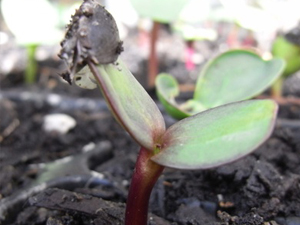If you love growing your own vegetables over summer then you’ll be pleased to know that many of them are easily grown from seed. The most popular vegetables such as tomatoes, cucumber, pumpkin, zucchini, beans and corn are great for beginners and there are many advantages to choosing seeds over seedlings.
Seeds are much cheaper than seedlings and will generally last a couple of years if stored correctly, as long as the use-by date is still current.
Choosing seeds instead of seedlings has a great environmental benefit. Seedlings are heavy to transport and use a lot of plastic, water and embodied energy in their production, whereas seeds are light, easy to transport and use minimal packaging.
You also have a much greater choice if you grow from seed, as only a small selection of the most popular vegetable varieties are produced as seedlings. You are not limited to what is available at the local nursery but can also take advantage of mail-order seed companies.
If you prefer to grow organic produce, choose seeds, as most seedlings aren’t produced organically, whereas there is a large range of organic seeds available.

If you grow open-pollinated, non-hybrid seed then you can save your own seed from year to year and cut out the middleman all together. Seed saving is a delight all of it own!
Growing from seed means that you can save space in the garden by propagating many plants close together, in a separate area first, rather than having to make room in the garden. Having your seedlings growing in a protected, sheltered area makes it easier to protect them from the cold and also from insects, snails and slugs. It allows you to get your plants growing strongly, ready for planting once the soil temperature has increased and they are more resilient to attack.
Propagating some vegetables first also means that, if you are pressed for time, you can simply check your seedlings for watering, rather than the garden beds, as your seeds and emerging seedlings will require more frequent attention than the established vegetables.
What do I need to seed?

Collect a few items first, before getting started. Seeds can be grown in egg cartons, toilet rolls or newspaper pots (see www.abc.net.au/gardening/factsheets/paper-pots/9431122). You can also propagate them in washed second hand punnets or seedling trays. If you are using toilet rolls snip at frequent intervals around the base and then fold in to create a bottom.
You also need a growing medium and seed raising mix or potting mix is fine. Potting mix can be a bit coarse so sift if necessary to get the big bits out.
You need a place to put the seeds once you have sown them. A warm, sheltered spot away from frost is best. This can be on the veranda, a sunny windowsill or under a cold frame or plastic cover.
Be careful not to disturb the seeds with watering so use a very fine rose on your watering can or a spray bottle.
Are you direct or indirect? To sow direct means to plant the seed straight into the garden bed. This is normally done for larger seeds or very fine seed that does not like to be disturbed, such as carrots or onions. Beans can be sown directly, for example, as they are large, easily spaced out and they germinate easily. The instructions on the back of the seed packet will tell you whether to sow direct or indirect.
Pricking out
The term pricking out means to gently move the new seedlings into a larger pot, and is done if the seedlings have been propagated in a punnet or tray rather than individually. Use a chopstick or similar item to lever the seedlings out from below, being careful not to pull on the leaves or stalk. This is generally done once the seedling has the first true leaves or is about an inch long. Place into a larger pot prepared with potting mix and firm the soil around the roots gently. It is much better to plant deeply at this stage, especially with tomatoes, as the seedling may fall over if it is too shallow and tomatoes will develop roots along the stem.
If you have grown your seeds individually in compostable pots, such as toilet rolls or jiffy pots, then you can simply plant them straight into the garden once they are large enough and the weather has become warmer.
Related Articles:
Companion Planting
Heard about companion planting but don’t know what it is or where to start? This video explores how to use companion plants to improve the health…
Garden Journaling – Slow down to tune in.
As we move through the year and our gardens evolve, there's something magical about documenting the journey. Garden journaling is an art that enables…
Strawberries
I adore strawberries (Fragaria sp.), and one of my earliest memories is a birthday cake absolutely heaving under the weight of a sack full of home…
Climate Resilient Gardening
Introduction Gardeners in Australia are facing a race against time as they experience the growing impact of climate change in their own gardens. The…




